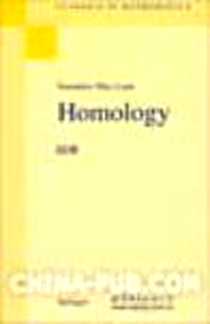《同调》
《同调》
出版时间:2009-8
出版社:世界图书出版公司
作者:Saunders Mac Lane
页数:422
《同调》前言[E]
In presenting this treatment of homological algebra, it is a pleasureto acknowledge the help and encouragement which I have had fromall sides. Homological algebra arose from many sources in algebra andtopology. Decisive examples came from the study of group extensionsand their factor sets, a subject I learned in joint work with OTTO SCHIL-LING. A further development of homological ideas, with a view to theirtopological applications, came in my long collaboration with SAHUELEZLENBERG; to both collaborators, especial thanks. For many yearsthe Air Force Office of Scientific Research supported my researchprojects on various subjects now summarized here; it is a pleasure toacknowledge their lively understanding Of basic science.
Both REINHOLD BAER and JOSEF SCHMID read and commented onmy entire manuscript; their advice has led to many improvements.ANDERS KOCK and JACOUES RIGUET have read the entire galley proofand caught many slips and obscurities. Among the others whose sug-gestions have served me well, I note FRANK ADAMS, LOUIS AUSLANDER,WILFRED COCKCROFT, ALBRECHT DOLD,GEOFFREY HORROCKS, FRIED-RICH KASCH, JOHANN LEICHT, ARUNAS LIULEVIC1US, JOHN MOORE, DIE-TBR PUFFE, JOSEPH YAO, and a number of my current students at theUniversity of Chicago —— not to mention the auditors of my lecturesat Chicago, Heidelberg, Bonn, Frankfurt, and Aarhus. My wife, DonoTHY,has cheerfully typed more versions of more chapters than she wouldlike to count. Messrs. SPRINTER have been unfailingly courteous in thepreparation of the book; in particular, I am grateful to F. K. SCHMIDT,the Editor of this series, for his support. To all these and others whohave helped me, I express my best thanks.
《同调》内容概要[E]
In presenting this treatment of homological algebra, it is a pleasureto acknowledge the help and encouragement which I have had fromall sides. Homological algebra arose from many sources in algebra andtopology. Decisive examples came from the study of group extensionsand their factor sets, a subject I learned in joint work with OTTO SCHIL-LING. A further development of homological ideas, with a view to theirtopological applications, came in my long collaboration with SAHUELEZLENBERG; to both collaborators, especial thanks. For many yearsthe Air Force Office of Scientific Research supported my researchprojects on various subjects now summarized here; it is a pleasure toacknowledge their lively understanding Of basic science.
《同调》作者简介[E]
Saunders Mac Lane was born on August 4,1909in Connecticut. He studied at Yale Universityand then at the University of Chicago and atG6ttingen, where he received the D. Phil. in 1934.He has taught at Harvard, Cornel1 and theUniversity of Chicago.Mac Lanes initial research was in logic andin algebraic number theory (valuation theory).With Samuel Eilenberg he published fifteenpapers on algebraic topology. A number of theminvolved the initial steps in the cohomologyof groups and in other aspects of homologicalalgebra - as well as the discovery of categorytheory. His famous undergraduate textbookSurvey of modern algebra, written jointly withG. Birkhoff, has remained in print for over50 years. Mac Lane is also the author of severalother highly successful books.
《同调》书籍目录[E]
IntroductionChapter I. Modules, Diagrams, and Functors 1. The Arrow Notation 2. Modules 3. Diagrams 4. Direct Sums 5. Free and Projective Modules 6. The Functor Horn 7. Categories 8. FunctorsChapter If. Homology of Complexes 1. Differential Groups 2. Complexes 3. Cohomology 4. The Exact Homology Sequence 5. Some Diagram Lemmas 6. Additive Relations 7. Singular Homology 8. Homotopy 9. Axioms for HomologyChapter III. Extensions and Resolutions 1. Extensions of Modules 2. Addition of Extensions 3. Obstructions to the Extension of Homomorphisms 4. The Universal Coefficient Theorem for Cohomology 5. Composition of Extensions 6. Resolutions 7. Injective Modules 8. Injective Resolutions 9.Two Exact Sequences for Extn 10. Axiomatic Description of Ext 11. The Injective EnvelopeChapter IV. Cohomol0gy of Groups 1. The Group Ring 2. Crossed Homomorphisms 3. Group Extensions 4. Factor Sets 5. The Bar Resolution
6. The Characteristic Class of a Group Extension 7. Cohomology of Cyclic and Free Groups 8. Obstructions to Extensions 9. Realization of Obstructions 10. SCHUR'S Theorem 11. Spaces with OperatorsChapter V. Tensor and Torsion Products 1. Tensor Products 2. Modules over Commutative Rings 3. Bimodules 4. Dual Modules 5. Right Exactness of Tensor Products . 6. Torsion Products of Groups 7. Torsion Products of Modules 8. Torsion Products by Resolutions 9. The Tensor Product of Complexes 10. The KONNETH Formula 11. Universal Coefficient TheoremsChapter VI. Types of Algebras 1. Algebras by Diagrams 2. Graded Modules 3. Graded Algebras 4. Tensor Products of Algebras 5. Modules over Algebras 6. Cohomology of free Abelian Groups 7. Differential Graded Algebras 8. Identities on Horn and 9.Coalgebras and HoPF AlgebrasChapter VII. Dimension 1. Homological Dimension 2. Dimensions in Polynomial Rings 3. Ext and Tor for Algebras 4. Global Dimensions of Polynomial Rings 5. Separable Algebras 6. Graded Syzygies 7. Local RingsChapter VIII. Products 1. Homology Products 2. The Torsion Product of Algebras 3. A Diagram Lemma 4. External Products for Ext 5. Simplicial Objects 6. Normalization 7. Acyclic Models 8. The EILENBERG-ZILBER Theorem 9. Cup ProductsChapter IX. Relative Homological Algebra 1. Additive Categories 2. Abelian Categories 3. Categories of Diagrams 4. Comparison of Allowable Resolutions 5. Relative Abelian Categories 6, Relative Resolutions 7. The Categorical Bar Resolution 8. Relative Torsion Products 9. Direct Products of RingsChapter X. Cohomology of Algebraic SystemsChapter XI. Spectral SequencesChapter XII. Derived FunctorsBibliographyList of Standard SymbolsIndex